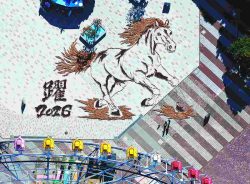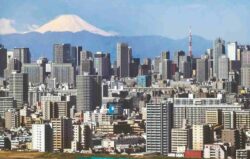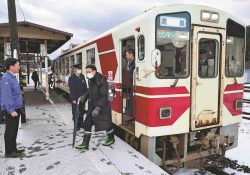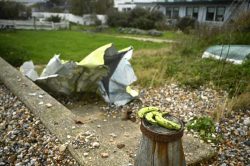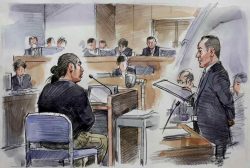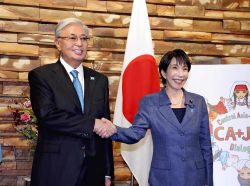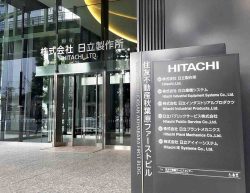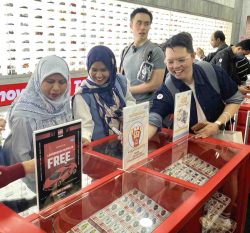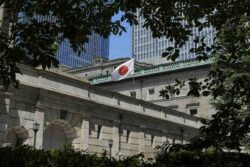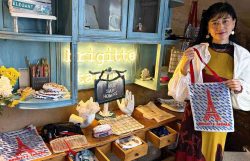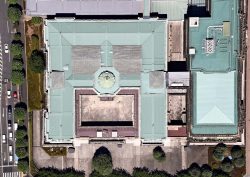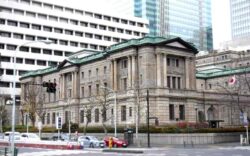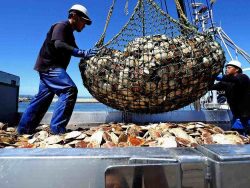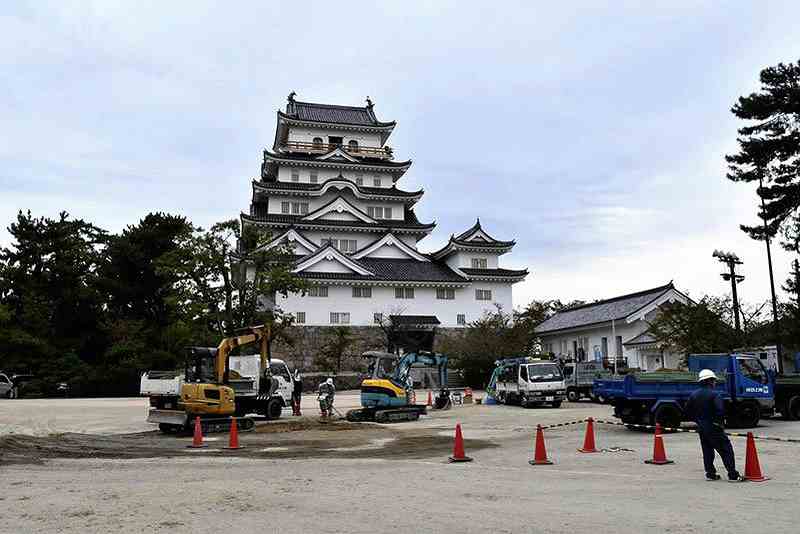
Fukuyama Castle’s tower is seen in October 2020 in Fukuyama, Hiroshima Prefecture, before renovations began.
November 18, 2021
FUKUYAMA, Hiroshima — Large-scale renovations are underway at Fukuyama Castle in Hiroshima Prefecture, as next year will mark the 400th anniversary of its construction.
The castle, built in 1622, is being renovated for the first time since 1966, when it was restored after most of its buildings were destroyed in World War II.
The castle tower and other facilities are being renovated, with walls added to the interior for earthquake resistance and the exterior walls repainted. The refurbished new Fukuyama symbol will be introduced to the public in March next year.
Of the parts to be restored on the castle tower, the restoration of the iron plates is the highlight. Originally, the northern side of the tower was covered with steel panels in preparation to defend against attacks by cannons and guns.
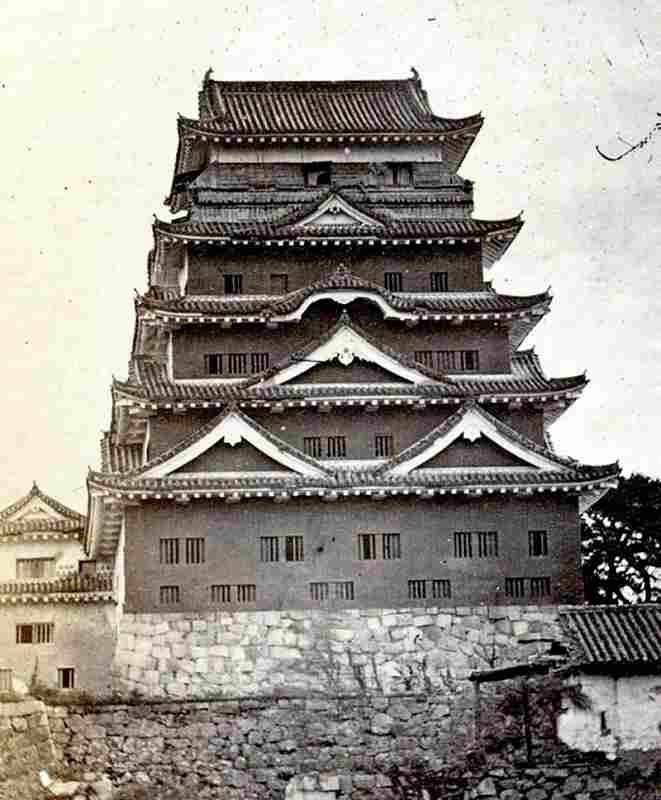
The castle tower is photographed from the north during the Meiji era. It looks blackish as it is covered with iron panels.
It is believed that this was because the south side of Fukuyama Castle was surrounded by moats and high stone walls, but the north side was less well defended. This is the only example of a castle tower equipped with such “steel armor” in all of Japan.
In a photo taken from the north side of the castle tower during the Meiji era (1868-1912), the walls appear blackish because black-painted steel plates — each 10 centimeters wide and 130 centimeters long — were nailed to the walls without any gaps. It is said that about 1,500 panels were used.
In April, the Fukuyama city government announced the discovery of two pieces of panels that are believed to have been used on the castle tower. According to experts, they are extremely important materials for the history of the castle’s architecture.
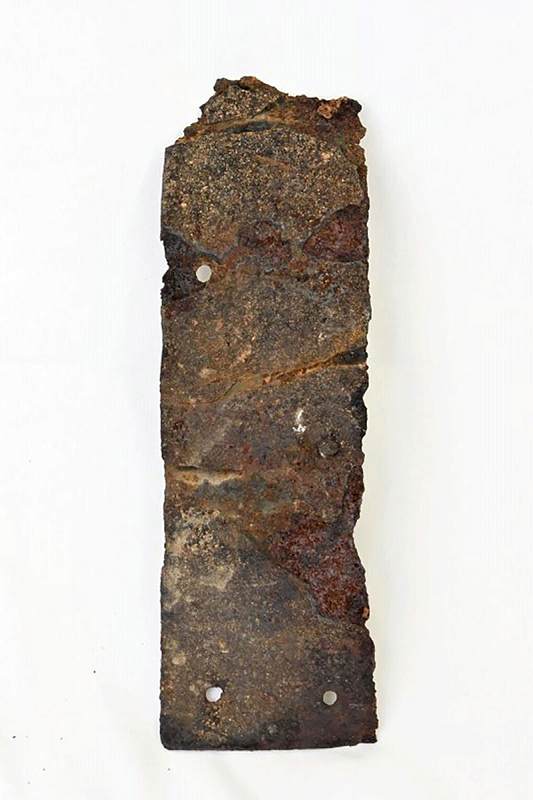
An object believed to be a piece of an iron panel originally installed to protect the castle tower
One of the panels found is 7.6 centimeters wide and 24.3 centimeters long, and the other is 11.3 centimeters wide and 25.4 centimeters long. The pieces are 1.5 to 2.8 millimeters thick. There are nine tack marks on the pieces, three of which still have pins in place. Both pieces are blackened and bent, showing signs of having been burned by high heat.
On Aug. 8, 1945, the castle tower was burned down in an air raid by the U.S. military. The panel pieces were kept by a man in Fukuyama, along with three roof tiles labeled “Fukuyama Castle tiles: U.S. Incendiary Bombs.” The tower was rebuilt in 1966, but due to technical problems, the paneling was not reproduced.
However, in this latest renovation, since some experts call the steel paneling an important feature that should be restored, the Fukuyama city government added it to the project.
Part of the renovation cost is being raised through crowdfunding. Donors who contribute ¥100,000 or more will be given the opportunity to have their names inscribed on one of the steel plates. Also, the names of people who give ¥10,000 or more will be written on roof tiles. Tiles with inscribed names and messages are already being installed at the top of the castle tower.
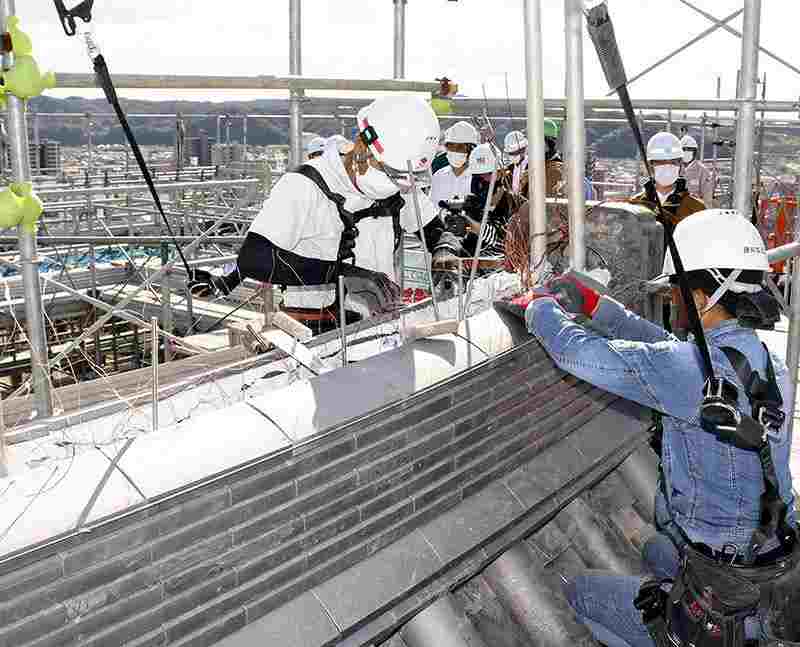
Workers install tiles bearing the names of donors on top of the castle tower, 35 meters above the ground.
Citizens’ tower of hope
Many of the buildings of Fukuyama Castle were rebuilt in 1966, with construction of the castle tower beginning the previous year and ending in just over a year. It is a seven-story reinforced concrete structure, and the interior is used as a museum.
When the castle was burned down, the residents were dismayed. In the 1960s, the then mayor announced the restoration of the castle tower and other buildings because 1966 marked the 50th anniversary of the Fukuyama city government. Most of the total project cost — ¥160 million of ¥190 million — was covered by donations from citizens.
According to Shuji Murata, who drew up the plans as an engineer, there were almost no documents on the structure of the castle, so he and his colleagues had to carefully examine old photographs with a magnifying glass.
Although the work continued from early morning to late at night every day, “no one complained about it, and we all worked as one toward the same goal,” Murata said. “Fukuyama Castle gave the citizens a glimmer of hope for post-war reconstruction.”

Turret taken from Kyoto
There seems to be a reason why Fukuyama Castle was built splendidly. In 1603, Tokugawa Ieyasu established the shogunate in Edo, now Tokyo, and ruled all of Japan. But there were many lords in western Japan, far from Edo, who were not close to the Tokugawa family, so the shogunate needed a way to monitor them closely. The first lord of Fukuyama Castle, Mizuno Katsunari, was a cousin of Ieyasu.
“The Tokugawa shogunate used Fukuyama as a base for controlling western Japan,” said Kosei Kanao, an ex-director of the Fukuyama Castle Museum.
Of all the castle buildings, the Fushimi turret is the most prestigious. It survived the fire during the war and is one of the few surviving original buildings of the castle.
Initially, this turret was in Kyoto and was part of Fushimi Castle, which was built by Toyotomi Hideyoshi, the ruler of Japan before Ieyasu.
It is said that after destroying the Toyotomi family, the Tokugawa family gave Katsunari the turret, which was moved to Fukuyama along with other turrets and gates. Now, the turret is designated as a national important cultural property and is one of Fukuyama’s most valuable tourist resources.
“It’s by far the most prestigious of the existing turrets in Japan,” said Masayuki Miura, a professor emeritus at Hiroshima University, who is a leading researcher on castle architecture. “It represented the legitimacy of the shogunate as the next rulers after the Toyotomi family.”
"Society" POPULAR ARTICLE
-

M4.9 Earthquake Hits Tokyo, Neighboring Prefectures
-

M7.5 Earthquake Hits Northern Japan; Tsunami Waves Observed in Hokkaido, Aomori and Iwate Prefectures
-

Tsukiji Market Urges Tourists to Avoid Visiting in Year-End
-

Israeli Tourists Refused Accommodation at Hotel in Japan’s Nagano Pref., Prompting Protest by Israeli Embassy and Probe by Prefecture
-

Beloved Cat Stationmaster Nitama in Wakayama Pref. Passes Away at 15
JN ACCESS RANKING
-

Keidanren Chairman Yoshinobu Tsutsui Visits Kashiwazaki-Kariwa Nuclear Power Plant; Inspects New Emergency Safety System
-

Imports of Rare Earths from China Facing Delays, May Be Caused by Deterioration of Japan-China Relations
-

Japan Pulls out of Vietnam Nuclear Project, Complicating Hanoi’s Power Plans
-

Govt Aims to Expand NISA Program Lineup, Abolish Age Restriction
-

Blanket Eel Trade Restrictions Rejected


